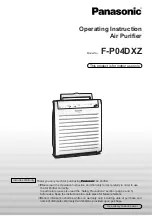
Commercial Air Conditioner
Model: heat pump, 10SEER UNITS
40
and moisture.
ACTION:
Remove and recover the refrigerant .Evacuate the system Charge
with fresh ,clean refrigerant.
B. The system pressure is below the chart pressure.
Cause
:A mixed refrigerant is present .
ACTION:
Remove and recover the refrigerant .Evacuate the system Charge with fresh ,clean
refrigerant.
COMPRESSOR REMOVAL PROCEDURES
USE THESE PROCEDURES ONLY IF A PROVEN BURN OUT OR A FAILED COMPRESSOR BY
ELECTRICAL CAUSES HAS BEEN DETERMINED.
CAUTION: After a server motor burn out the products of the burn out the products of the burn out
may be acidic. The technician should wear rubber gloves and eye protection to prevent injury.
Use the following procedure for compressor removal ONLY after determining that the compressor has
failed.
1. DISCONNECT THE MAIN POWER SOURCE TO THE UNIT AND LOCK THE DISCONNECT
SWITCH IN THE OPEN POSITION.
2. Disconnect the electrical wiring at the compressor identifying each wire and its location.
3. Remove the refrigerant charge from the entire system using proper recovery pressures.
4. Remove the failed compressor.
A. Unsolder the suction and discharge lines at the compressor stubs.
B. Remove the compressor hold down bolts.
C. Place the failed compressor on a smooth surface to remove the mounting grommets and
sleeves for use with the new compressor .
D. Prevent any contamination from entering the refrigerant lines.
5. Conduct an acid test on the oil from the failed compressor .
A. Secure a generous sample of oil from the failed compressor.
B. Follow the oil test kit instructions to determine the degree of compressor burn out.
.
●
As a general rule, oil with a test number less than 0.05 indicates a mild burn out.
●
Oil with a test number greater than 0.05 indicates a serve burn out .
●
Some oil test kits indicate severity by color charge .
●
As a guide ,burn out classifications are as follows:
oil clear ,no color ,Possibly no burn out –mechanical failure.
oil clear ,slight color ,Possibly a mild burn out .
oil very dirty ,strong odor test >0.05 –severe burn out .
Note: Dispose of any contaminated refrigerant oil in accordance with all environmental regulations
and procedures.
6. Use the following procedures with units having mild to severe burn outs.
A. After compressor removal ,insert a clean ,lint free swab into the system ‘s suction and
discharge lines to determine the extent of contamination.
B. If contamination is noted for a considerable depth ,replace with new tubing.
C. Check that the new compressor has no shipping damage. The line connections must come
sealed from the factory .Ensure that it is correct replacement compressor of the same size and
electrical characteristics as the original.
D. Place the new compressor in the unit and install the mounting bolts.
E. Remove the caps from the compressor stubs ,clean the lines and stubs, and braze joints
together.
Warnings:
1. KEEP CONTAMINATIONS OUT OF THE LINES,
2. USE MINIMUM 5% SILVER FOR COPPER TO COPPER CONNECTIONS.
USE MINIMUM 35% SILVER FOR COPPER TO STEEL CONNECTIONS.
3. PURGE DRY NITROGEN THROUGH THE LINES TO PREVENT OXIDATION.
F. Inspect all other components such as check valve and electrical components for copper
operation. Replace any if necessary.
G. After all connections are made ,open all valves pressurize to 150 psi with dry nitrogen and leak
test with liquid detergent. If a leak is found ,repair it after removing the nitrogen ,and recheck.
H. After leak testing ,recover any test refrigerant.
I. Triple evacuate the system.
.Evacuate through both high and low sides of the system.
.Evacuate to 1500 microns twice and 500 microns the last time.





































